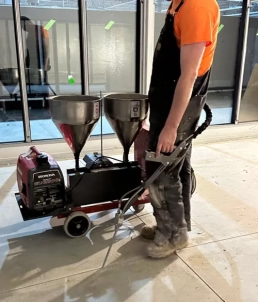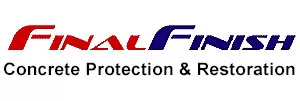Commercial Concrete Joint Caulking
Protect the integrity of your concrete floors with joint caulking
With over 20 years of experience coupled with state-of-the-art equipment and industry-best joint caulking products, Final Finish has the expertise to ensure a long-lasting and reliable seal
The Final Finish team understands the importance of proper joint assessment, sealant selection, and thorough joint preparation to do the job right the first time. Final Finish is committed to providing high-quality services and utilizing advanced techniques to meet the specific needs and requirements of its commercial clients.
As a certified applicator, we offer a variety of high-quality joint fillers for both new construction and floor remodels. Some of the products we use include Dow Sil 858/890SL Joint Sealant, Euclid Chemical’s Euco 700 and Euco Qwik Joint UVR, Metzger McGuire’s Edge Pro 80, Edge Pro 90, RS88, and MM80, as well as VersaFlex.
By choosing Final Finish for your commercial concrete joint caulking needs, you can benefit from their extensive experience, use of top-notch products, and commitment to delivering exceptional service at a fair price.
Benefits of commercial concrete joint caulking
-
- Preventing water infiltration: Sealed joints protect the concrete from water damage, such as cracking, spalling, or erosion caused by freeze-thaw cycles or excessive moisture.
- Increased lifespan: By minimizing the impact of water and moisture, joint caulking helps preserve the structural integrity and extends the lifespan of the concrete surfaces.
- Protection against chemicals and debris: Sealed joints act as a barrier against the intrusion of chemicals, oil, dirt, and other contaminants, reducing the potential for staining or deterioration.
- Enhanced aesthetics: Properly sealed joints provide a clean and finished appearance, improving the overall aesthetic appeal of the concrete surfaces.
It is important to note that joint caulking should be performed by experienced professionals who are knowledgeable about the appropriate sealants and techniques for different joint types and conditions. Proper surface preparation and the selection of the right caulking material are critical for ensuring a successful and long-lasting joint seal.

We provide services for the following newly installed and pre-existing concrete surfaces.
-
- Commercial Floors: This includes concrete flooring in various commercial spaces such as retail stores, offices, warehouses, manufacturing facilities, restaurants, and hospitals.
- Commercial Driveways and Parking Lots: Concrete is often used for driveways and parking lots in commercial properties due to its durability and ability to withstand heavy vehicular traffic.
- Sidewalks and Walkways: Concrete sidewalks and walkways provide a durable and safe pedestrian path in commercial areas such as shopping centers, office complexes, and public spaces.
- Loading Docks: Concrete surfaces are frequently used for loading docks in warehouses and distribution centers to withstand the weight of heavy equipment and facilitate smooth loading and unloading operations.
- Industrial Floors: In industrial settings, such as factories and manufacturing plants, concrete floors are often used due to their ability to withstand heavy equipment, chemicals, and foot traffic.
Key aspects of commercial concrete joint caulking:
-
- Joint Assessment: A professional contractor will assess the condition of the joints to determine if caulking is necessary. They will consider factors such as joint type, width, depth, movement requirements, and exposure to different elements.
- Selection of Sealant: Based on the assessment, the contractor will choose the appropriate sealant material for the specific joint. Common sealant options include silicone, polyurethane, or polysulfide-based sealants, which offer flexibility, durability, and weather resistance.
- Joint Preparation: Before applying the sealant, the joints need to be thoroughly cleaned and prepared. This involves removing any debris, loose material, or existing failed sealant to ensure proper adhesion and effectiveness of the new sealant.
- Application of Sealant: The selected sealant is applied to the joint using specialized tools and equipment. The sealant is carefully applied to fill the joint completely, ensuring a watertight and durable seal.
- Curing and Maintenance: The sealant needs time to cure and form a strong bond. Final Finish provides guidelines on the required curing time and any necessary maintenance instructions.
Concrete expansion joint repair:
Concrete expansion joints play a crucial role in accommodating the natural movement and expansion of concrete slabs due to temperature changes, moisture fluctuations, and other factors. Over time, these joints may deteriorate or require repair to maintain their functionality. Concrete expansion joint repair involves addressing issues such as joint damage, deterioration, or failure, ensuring the integrity of the joint system. Here are some key considerations and methods for concrete expansion joint repair:
- Assessment and Preparation:
- Begin by thoroughly inspecting the expansion joints for any signs of damage or failure, such as cracking, spalling, or displacement.
- Clean the joints by removing any debris, dirt, or loose material using a wire brush or compressed air. This step ensures proper adhesion of repair materials.
- Joint Resealing:
- For minor damage or cracks in the joint sealant, a resealing approach can be adopted.
- Remove the old sealant using a scraper or a joint sealant removal tool. Take care not to damage the edges of the joint.
- Clean the joint surface to remove any residue or loose material.
- Apply a suitable joint sealant, following the manufacturer’s instructions. Typically, a flexible, elastomeric sealant is used for expansion joints to accommodate movement.
- Joint Reconstruction:
- In cases where the joint has significant damage or has failed, reconstruction may be necessary.
- Remove the damaged joint by using specialized tools such as saws or grinders to create clean, straight edges.
- Clean the joint thoroughly to remove debris and ensure proper bonding of the new material.
- Apply a suitable joint filler material, such as a polyurethane or epoxy-based product, into the joint. These materials provide flexibility and durability, allowing for movement and long-term performance.
- Joint Edge Protection:
- To enhance the durability and longevity of repaired expansion joints, it is essential to protect the edges from further damage.
- Apply a joint edge protection system, such as joint edge sealant or a specialized joint edge profile, to prevent water infiltration and to maintain the integrity of the joint.
- Monitoring and Maintenance:
- Regularly inspect the repaired expansion joints to ensure their effectiveness and identify any signs of future deterioration.
- Perform routine maintenance, including cleaning and resealing as needed, to prevent further damage and extend the lifespan of the repaired joints.
It’s important to note that the specific repair methods and materials may vary based on the type of expansion joint and the severity of the damage. Hiring a professional concrete contractor experienced in expansion joint repair is recommended for accurate assessment, appropriate repair techniques, and long-lasting results.
By promptly addressing and repairing damaged or deteriorated expansion joints, you can maintain the structural integrity of concrete slabs, prevent further issues, and ensure the longevity and functionality of the joint system.
